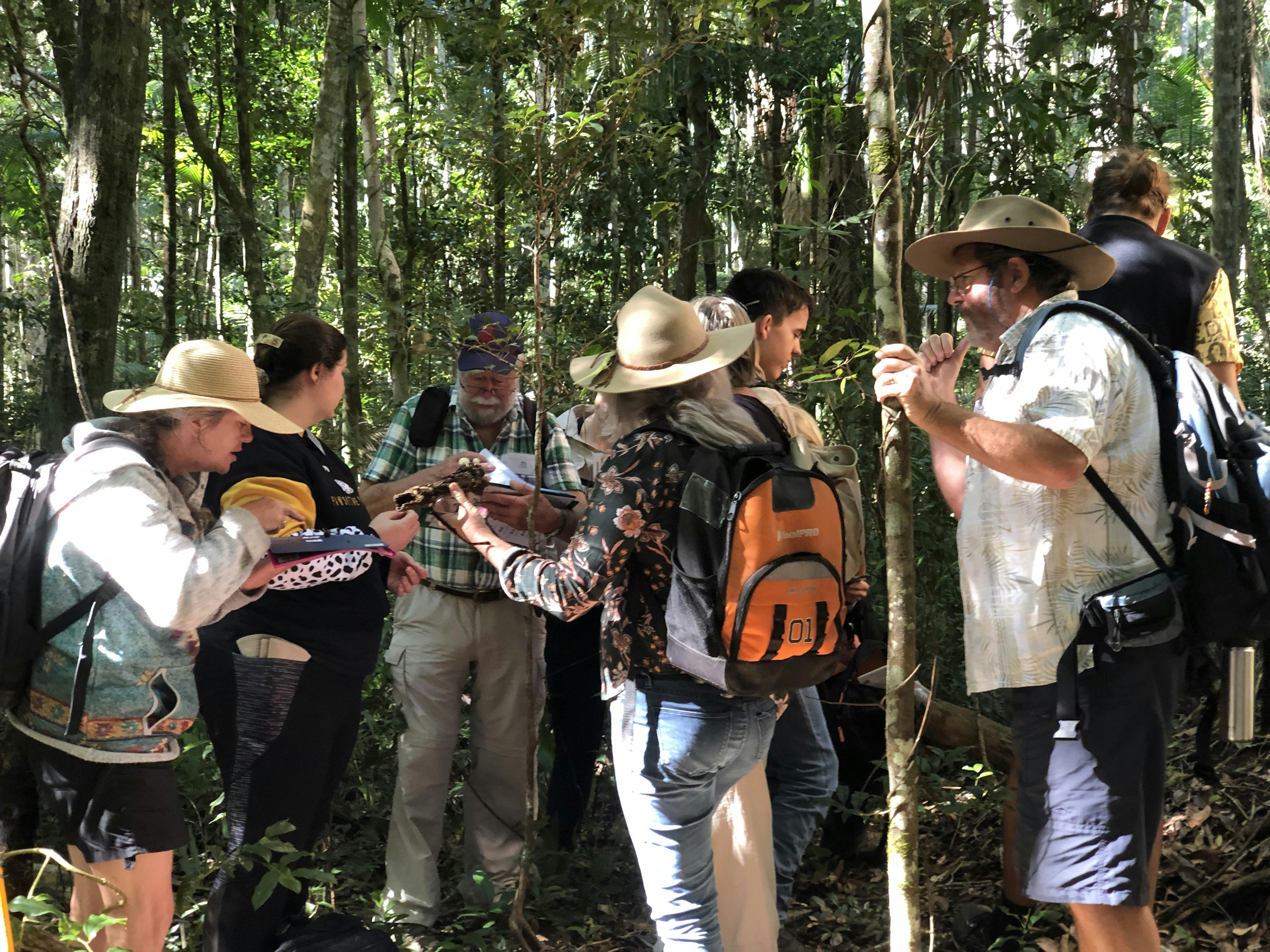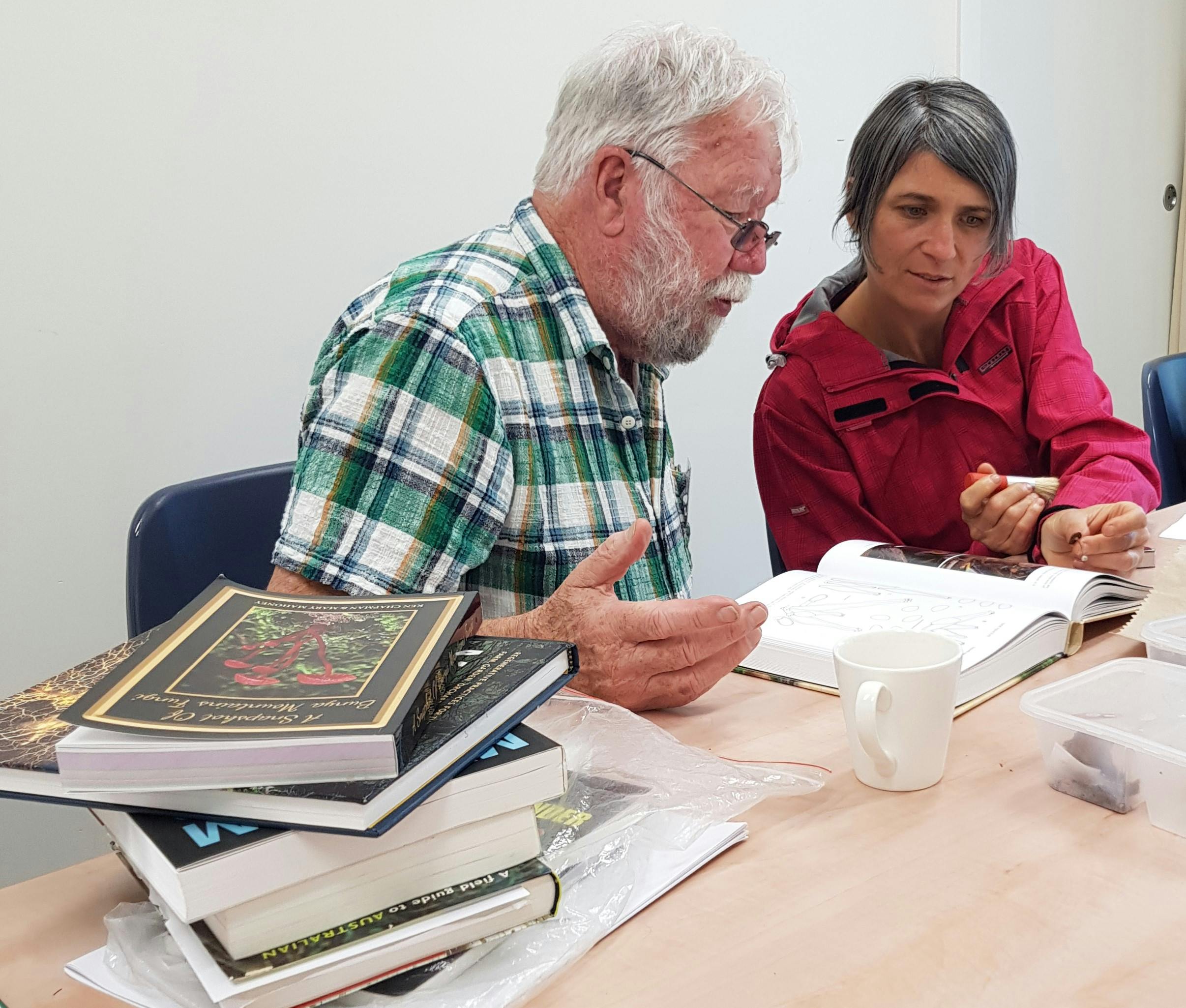Skip to content

 Citizen mycology at the Cooloola BioBlitz
Citizen mycology at the Cooloola BioBlitz
The third organized by Cooloola Coastcare, was held at Rainbow Beach on 14 – 16th of May 2021. engaged citizen scientists in a whole range of disciplines aiming to record as much wildlife as possible in 48 hours.


Fungi foray fun at Bymien Forest track
Patrick Leonard () and Sandra Tuszynska () led the fungi forays at the Bymien Forest track and a section of the Pettigrews Road circuit. Ninety-three fungi were recorded, 44 identified to species, 30 to genus and 19 to order. Some rare fungi not previously recorded for the area were encountered.


Patrick and Sandra working through a taxonomic key
Despite the vital role in nutrient cycling, plant and animal nutrition, fungi are one of the least studied of all taxa. Around 12 000 out of 50-250 000 estimated fungal species have been described in Australia. They are not even protected by the Environmental Protection and Biodiversity Conservation Act (1999) which protects almost 2000 animal and plant species but not fungi.


Citizen mycologists checking the pore structure with a magnifying lens on polypore fungi decomposing a log
Queensland fungi receive a very low priority in ecological site assessments and the QLD Herbarium employs only one mycologist part-time, without providing an identification service, as is the case for plants. Only a handful of citizen mycologists in the state actually devote time to identifying fungi. Not surprisingly, ~50% of macrofungi in Queensland are still undescribed, demonstrating a real need for education, sharing of expertise and citizen science engagement in mycology.


Citizen scientists working on recording and identifying collected specimen
Although Cooloola BioBlitz participants were encouraged to upload their to iNaturalist, and 150 observations have been supplied by 25 observers, photos alone are not enough in fungi identification to species level. Unless the species is known and easily recognised, correct fungi ID requires microscopic examination of spores and other features. Additionally, iNaturalist’s AI is still in its infancy for Australian species, especially fungi, unable to suggest correct ID for most. However, having a good photographic record of fungal biodiversity can reveal a lot of ecological data about species distribution and the functional groups in a given ecosystem. Such records are also useful in tracking effects of disturbances such as droughts, fires and land management practices such as controlled burning and grazing, which significantly impact fungal diversity.


Patrick, Tina and Gillian (members of the Mycology Research Project) trying to identify a Marasmius species
However, the project plays a crucial role in studying fungal diversity and distribution. Mycologist at the National Herbarium of Victoria, Tom May, founded Fungimap to help people identify commonly found fungi and to map Australia’s fungal diversity. is one of the largest citizen science projects and biggest contributor of fungi records to the Atlas of Living Australia. It’s publication, – the Fungimap Guide to Australian Fungi, was produced entirely by volunteers with plans to publish another volume. Through projects like Fungimap, iNaturalist’s identifying power for Australian fungi, will continually be updated and improved. Records from the Cooloola BioBlitz are being submitted to the Fungimap project on iNaturalist.


Taking good images of fungi can be tricky
Nevertheless, mycological expertise are needed to correctly ID the more rare species which are not easily identified due to scarcity or lack of data, and to name the ~50% of the still undescribed fungi species in Queensland. This requires collecting permits, collecting and describing specimens, spore printing, microscopy of spores, working through taxonomic keys, drying and submission of specimen to the QLD Herbarium, eventually molecular analysis may also be necessary. While a handful of dedicated QMS members, are avid citizen mycologists who contribute their expertise to fungal taxonomy, many more such citizens are required, to get to know and conserve our precious fungi.


Picnic break during the fungi survey at the Bymien Forest track
Clearly, this indicates the need for mycologists, citizen scientists and technology to collaborate in evolving mycology to the status of other taxonomic groups. We’d like to encourage citizen scientists to join the , attend future BioBlitz events, join and submit images of fungi to the and learn about fungi from other enthusiasts on the facebook page. Not only because it is exceptional fun, but also because fungi deserve to be recognised and studied as a fundamental part of ecosystems, without which humanity, plants and wildlife cannot survive. Citizen mycology is a powerful opportunity to shine the spotlight on and help brighten up the future of fungi.


Picnic lunch at the Pettigrews Road circuit fungi survey
Want to print your doc?
This is not the way.
This is not the way.

Try clicking the ··· in the right corner or using a keyboard shortcut (
CtrlP
) instead.